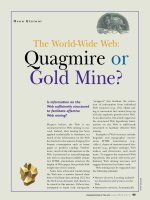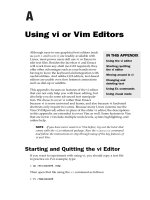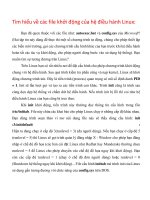Quagmire or Gold Mine?
Bạn đang xem bản rút gọn của tài liệu. Xem và tải ngay bản đầy đủ của tài liệu tại đây (233.32 KB, 4 trang )
COMMUNICATIONS OF THE ACM
November 1996/Vol. 39, No. 11
65
Skeptics believe the Web is too
unstructured for Web mining to suc-
ceed. Indeed, data mining has been
applied traditionally to databases, yet
much of the information on the Web
lies buried in documents designed for
human consumption such as home
pages or product catalogs. Further-
more, much of the information on the
Web is presented in natural-language
text with no machine-readable seman-
tics; HTML annotations structure the
display of Web pages, but provide little
insight into their content.
Some have advocated transforming
the Web into a massive layered data-
base to facilitate data mining [12], but
the Web is too dynamic and chaotic to
be tamed in this manner. Others have
attempted to hand code site-specific
“wrappers” that facilitate the extrac-
tion of information from individual
Web resources (e.g., [8]). Hand cod-
ing is convenient but cannot keep up
with the explosive growth of the Web.
As an alternative, this article argues for
the structured Web hypothesis: Infor-
mation on the Web is sufficiently
structured to facilitate effective Web
mining.
Examples of Web structure include
linguistic and typographic conven-
tions, HTML annotations (e.g.,
<title>), classes of semi-structured doc-
uments (e.g., product catalogs), Web
indices and directories, and much
more. To support the structured Web
hypothesis, this article will survey pre-
liminary Web mining successes and
suggest directions for future work.
Web mining may be organized into
the following subtasks:
• Resource discovery. Locating unfamil-
iar documents and services on the
Web.
• Information extraction. Automatically
Oren Etzioni
TERRY WIDENER
The World-Wide Web:
Quagmire or
Gold Mine?
Is information on the
Web sufficiently structured
to facilitate effective
Web mining?
66
November 1996/Vol. 39, No. 11
COMMUNICATIONS OF THE ACM
extracting specific information
from newly discovered Web
resources.
• Generalization. Uncovering gen-
eral patterns at individual Web
sites and across multiple sites.
Resource Discovery
Web resources fall into two class-
es: documents and services. The
bulk of the work on resource dis-
covery focuses on the automatic
creation of searchable indices of
Web documents. The most popu-
lar indices have been created by
Web robots such as WebCrawler
and AltaVista, which scan mil-
lions of Web documents and
store an index of the words in the
documents. A person can then
ask for all the indexed docu-
ments that contain certain key-
words. There are over a dozen
different indices currently in
active use, each with a unique
interface and a database covering
a different fraction of the Web.
As a result, people are forced to
repeatedly try and retry their
queries across different indices.
Furthermore, the indices return
many responses that are irrele-
vant, outdated, or unavailable,
forcing the person to manually
sift through the responses search-
ing for useful information.
MetaCrawler (http://www.
metacrawler.com) represents
the next level in the informa-
tion food chain by providing a
single, unified interface for
Web document searching [4].
MetaCrawler’s expressive query
language allows searching for
phrases and restricting the
search by geographic region or
by Internet domain (e.g., .gov).
Metacrawler posts keyword
queries to nine searchable
indices in parallel; it then col-
lates and prunes the responses
returned, aiming to provide users
with a manageable amount of high-
quality information. Thus, instead
of tackling the Web directly,
MetaCrawler mines robot-created
searchable indices.
Future resource discovery sys-
tems will make use of automatic
text categorization technology to
classify Web documents into cate-
gories. This technology could facil-
itate the automatic construction of
Web directories such as Yahoo by
discovering documents that fit
Yahoo categories. Alternatively, the
technology could be used to filter
the results of queries to searchable
indices. For example, in response
to a query such as “Find me prod-
uct reviews of Encarta,” a discovery
system could take documents con-
taining the word “Encarta” found
by querying searchable indices,
and identify the subset that corre-
sponds to product reviews.
Information Extraction
Once a Web resource has been dis-
covered, the challenge is to auto-
matically extract information from
it. The bulk of today’s information-
extraction systems identify a fixed
set of Web resources and rely on
hand-coded “wrappers” to access
the resource and parse its
response. To scale with the growth
of the Web, miners need to dynam-
ically extract information from
unfamiliar resources, thereby elim-
inating or reducing the need for
hand coding. We now survey sever-
al such systems.
The Harvest system relies on mod-
els of semi-structured documents to
improve its ability to extract informa-
tion [1]. For example, it knows how to
find author and title information in
Latex documents and how to strip
position information from Postscript
files. In one demonstration, Harvest
created a directory of toll-free num-
Some have advocat-
ed transforming the
Web into a massive
layered database to
facilitate data min-
ing, but the Web is
too dynamic and
chaotic to be tamed
in this manner.
COMMUNICATIONS OF THE ACM
November 1996/Vol. 39, No. 11
67
bers by extracting them from a large set of Web
documents (see />harvest/demobrokers.html). Harvest neither discovers
new documents nor learns new models of document
structure. However, Harvest easily handles new docu-
ments of a familiar type.
FAQ-Finder extracts answers to frequently asked
questions (FAQ) from FAQ files available on the Web
[6, 11]. Like Harvest, FAQ-Finder relies on a model of
document structure. A user poses a question in nat-
ural language and the text of the question is used to
search the FAQ files for a matching question. FAQ-
Finder then returns the answer associated with the
matching question. Because of the semi-structured
nature of the files, and because the number of files is
much smaller than the number of documents on the
Web, FAQ-Finder has the potential to return higher
quality information than general-purpose searchable
indices.
Both Harvest and FAQ-Finder have two key limita-
tions. First, both systems focus exclusively on Web
documents and ignore services (the same holds true
for Web indices as well). Second, both Harvest and
FAQ-Finder rely on a pre-specified description of cer-
tain fixed classes of Web documents. In contrast, the
Internet Learning Agent (ILA) and Shopbot are two
Web miners that rely on a combination of test queries
and domain-specific knowledge to automatically
learn descriptions of Web services (e.g., searchable
product catalogs, personnel directories, and more).
The learned descriptions can be used to enable auto-
matic information extraction by intelligent agents
such as the Internet Softbot [5].
ILA learns to extract information from unfamiliar
resources by querying them with familiar objects and
matching the output returned against knowledge
about the query objects [10]. For example, ILA
queries the University of Washington personnel
directory with the entry “Etzioni” and recognizes the
third output token (685–3035) as his phone number.
Based on this observation, ILA might hypothesize
that the third token output by the directory is the
phone number of the person mentioned in the
query. This learning process has a number of sub-
tleties. For example, the output token “oren” could
be either Etzioni’s userid or first name. To discrimi-
nate between these two competing hypotheses, ILA
will attempt to query with someone whose userid is
different from her first name. In the experiments
reported in [10], ILA successfully learned to extract
information such as phone numbers and email
addresses from the Internet server “Whois” and from
the personnel directories of a dozen universities.
Shopbot learns to extract product information
from Web vendors [3]. Shopbot borrows from ILA
the idea of learning by querying with familiar objects.
However, Shopbot tackles a more ambitious task.
Shopbot takes as input the address of a store’s home
page as well as knowledge about a product domain
(e.g., software), and learns how to shop at the store.
Specifically, Shopbot searches the store’s Web to find
the store’s searchable product catalog, learns the for-
mat in which product descriptions are presented, and
from these descriptions learns to extract product
attributes such as price. Shopbot learns by querying
the store for information on popular products, and
analyzing the store’s responses. In the software shop-
ping domain, Shopbot was given the home pages for
12 online software vendors. Shopbot learned to
extract product information from each of the stores,
including the product’s operating system (Mac or
Windows), and more. In a preliminary user study,
Shopbot users were able to shop four times faster
(and find better prices) than users relying only on a
Web browser [3]. Current work on Shopbot explores
the problem of autonomously discovering vendor
home pages.
Generalization
Once we have automated the discovery and extrac-
tion of information from Web sites, the natural next
step is to attempt to generalize from our experience.
Yet, virtually all machine learning systems deployed
on the Web (see [7] for some examples) learn about
their user’s interests, instead of learning about the
Web itself. A major obstacle when learning about the
Web is the labeling problem: data is abundant on the
Web, but it is unlabeled. Many data mining tech-
niques require inputs labeled as positive (or negative)
examples of some concept. For example, it is relative-
ly straightforward to take a large set of Web pages
labeled as positive and negative examples of the con-
cept “home page” and derive a classifier that predicts
whether any given Web page is a home page or not;
unfortunately, Web pages are unlabeled.
Techniques such as uncertainty sampling [9]
reduce the amount of labeled data needed, but do
not eliminate the labeling problem. Clustering tech-
niques do not require labeled inputs, and have been
applied successfully to large collections of documents
(e.g, [2]). Indeed, the Web offers fertile ground for
document clustering research. However, because
clustering techniques take weaker (unlabeled) inputs
than other data mining techniques, they produce
weaker (unlabeled) output. We consider an
approach to solving the labeling problem that relies
on the observation that the Web is much more than a
collection of linked documents.
The Web is an interactive medium visited by
millions of people each day. Ahoy! (.
washington.edu/research/ahoy) represents an
attempt to harness this source of power to solve the
labeling problem. Ahoy! takes as input a person’s
name and affiliation and attempts to locate the per-
son’s home page. Ahoy! queries MetaCrawler and
uses knowledge of institutions and home pages to fil-
ter MetaCrawler’s output. Since Ahoy!’s filtering
algorithm is heuristic, it asks its users to label its
answers as correct or incorrect. Ahoy! relies on its ini-
tial power to draw numerous users to it and to solicit
their feedback; it then uses this feedback to solve the
labeling problem, make generalizations about the
Web, and improve its performance. By relying on
feedback from multiple users, Ahoy! rapidly collects
the data it needs to learn; systems focused on learn-
ing an individual user’s taste do not have this luxury.
Finally, note that Ahoy!’s boot-strapping architecture
is not restricted to learning about home pages; user
feedback may be harnessed to provide training data
in a variety of Web domains.
Conclusion
In theory, the potential of Web mining to help peo-
ple navigate, search, and visualize the contents of the
Web is enormous. This brief and selective survey
explored the question of whether effective Web min-
ing is feasible in practice. We reviewed several
promising prototypes and outlined directions for
future work. In essence, we have gathered prelimi-
nary evidence for the structured Web hypothesis;
although the Web is less structured than we might
hope, it is less random than we might fear.
Acknowledgments
I would like to thank my close collaborator, Dan
Weld, for his numerous contributions to the softbots
project and its vision. I would also like to thank my co-
softbotists David Christianson, Bob Doorenbos, Marc
Friedman, Keith Golden, Nick Kushmerick, Cody
Kwok, Neal Lesh, Mark Langheinrich, Sujay Parekh,
Mike Perkowitz, Erik Selberg, Richard Segal, and
Jonathan Shakes. Thanks are due to Steve Hanks and
other members of the UW AI group for helpful dis-
cussions and collaboration. This research was funded
in part by Office of Naval Research grant 92-J-1946, by
ARPA / Rome Labs grant F30602-95-1-0024, by a gift
from Rockwell International Palo Alto Research, and
by National Science Foundation grant IRI-9357772.
References
1. Brown, C.M., Danzig, P.B. Hardy, D., Manber, U., and Schwartz,
M.F. The harvest information discovery and access system. In Pro-
ceedings of the 2d International World Wide Web Conference, 1994, pp.
763–771. Available from orado. edu/pub/cs/
techreports/schwartz/Harvest.Conf.ps.Z.
2. Cutting, D.D., Karger, J. Pedersen, and Turkey, J. Scatter/gath-
er: A cluster-based approach to browsing large document col-
lections. In Proceedings of the Fifteenth Interntional Conference on
Research and Development in Information Retrieval (Copenhagen,
Denmark), June 12, 1992, pp. 318–329.
3. Doorenbos, R.B. Etzioni, O. and Weld, D.S. A scalable compar-
ison-shopping agent for the world-wide web. Technical Report
96–01–03, University of Washington, Dept. of Computer Sci-
ence and Engineering, January 1996. Available via ftp from
pub/ai/ at ftp.cs.washington.edu.
4. Etzioni, O. Moving up the information food chain: Deploying
softbots on the Web. In Proceedings of the Fourteenth National
Conference on AI, 1996.
5. Etzioni, O. and Weld, D. A softbot-based interface to the Inter-
net. Commun. ACM 37, 7 (Jul. 1994), 72–76; See http://
www.cs.washington.edu/research/softbots.
6. Hammond, K., Burke, R., Martin, C., and Lytinen, S. FAQ
finder: A case-based approach to knowledge navigation. In
Working Notes of the AAAI Spring Symposium: Information
gathering from Heterogeneous, Distributed Enviornments,
1995, AAAI Press, Stanford University, pp. 69–73, To order a
copy, contact
7. Knoblock, C. and Levy, A., Eds. Working Notes of the AAAI
Spring Symposium on Information Gathering from Heteroge-
neous, Distributed Environments, AAAI Press, Stanford Uni-
versity, 1995. AAAI Press. To order a copy, contact
8. Krulwich, B. The bargainfinder agent: Comparison price shop-
ping on the internet. In J. Williams, Ed., Bots and Other Internet
Beasties. SAMS.NET, 1996. />9. Lewis, D. and Gale, W. Training text classifiers by uncertainty
sampling. In Proceedings of the Seventeenth Annual International
ACMSIGIR Conference on Research and Development in Information
Retrieval, 1994.
10. Perkowitz, M. and Etzioni, O. Category translation: Learning
to understand information on the internet. In Proceedings of
the Fifteenth International Joint Conference on AI, (Montreal,
Can.), Aug. 1995, pp. 930–936
11. Whitehead, S. D. Auto-faq: An experiment in cyberspace
leveraging. In Proceedings of the Second International WWW
Conference, vol. 1, (Chicago), 1994, pp. 25–38, (See also:
/>/whitehead/whitehead.html).
12. Zaiane, O.R. and Jiawei, H. Resource and knowledge discov-
ery in global information systems: A preliminary design and
experiment. In Proceedings of Knowledge Database Discovery’95
1995, pp. 331–336,
OREN ETZIONI () is an associate pro-
fessor in the Department of Computer Science and Engineering at
the University of Washington in Seattle.
Permission to make digital/hard copy of part or all of this work for personal
or classroom use is granted without fee provided that copies are not made or
distributed for profit or commercial advantage, the copyright notice, the title
of the publication and its date appear, and notice is given that copying is by
permission of ACM, Inc. To copy otherwise, to republish, to post on servers,
or to redistribute to lists requires prior specific permission and/or a fee.
© ACM 0002-0782/96/1100 $3.50
C
68
November 1996/Vol. 39, No. 11
COMMUNICATIONS OF THE ACM









